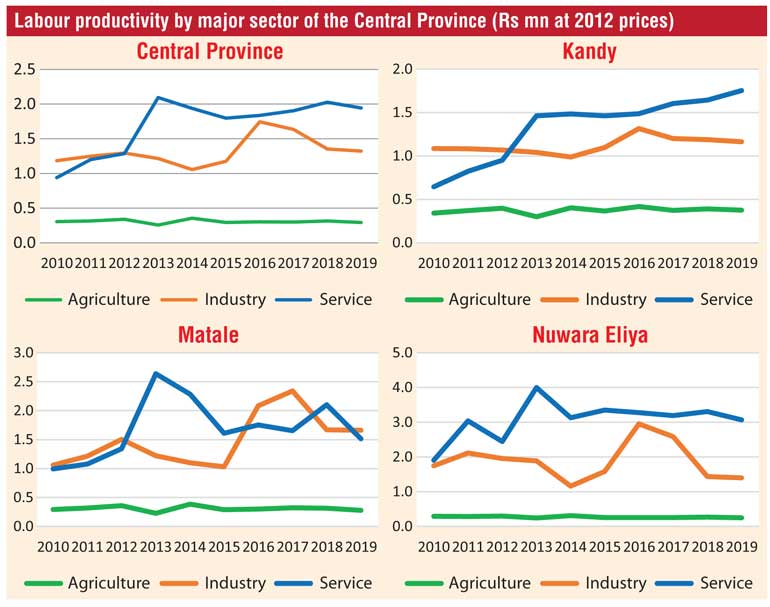Monday Apr 21, 2025
Monday Apr 21, 2025
Tuesday, 2 August 2022 02:52 - - {{hitsCtrl.values.hits}}

By Tilak Abeysinghe
While studying district level disparities and how districts have converged and diverged over the last decade under different indicator categories, we came to notice three distinct features in agriculture labour productivity relative to industry and service sectors. 1. Agriculture labour productivity is substantially lower across all the districts. 2. Agriculture labour productivity has been stagnant across all the districts except for Colombo and Gampaha districts. 3. Labour productivity in industry and service sectors show some progressive convergence of the districts but not so in the agriculture sector.
The first two effects can be seen in the chart for the Central Province. This pattern is similar for all the districts except for Colombo and Gampaha districts. (The full study is available at: https://gamanicoreafoundation.lk/publications/.)
Among productivity measures, labour productivity takes a prominent place for a number of reasons. First, improving living standards requires sustained growth in labour productivity. Second, from time immemorial man has used tools and knowhow to improve his productivity. Therefore, other factors of production (physical capital, human capital, innovation) play complementary roles in the task of improving labour productivity. Third, the competitiveness of modern economies depends on to what extent improvements in labour productivity could counter rising labour costs.
The key question is why the agriculture labour productivity is not only low but also stagnant. It is unlikely that it is the lack of productivity enhancing factors such as land, water, technical knowhow, etc. that has led to lower labour productivity in agriculture. The problem seems to lie in the pricing of the agricultural products. The aggregate output or value added is obtained using prevailing prices and then deflated to obtain the constant price output or value added. In value terms, the standard labour productivity measure is nothing but an alternative measure of per-capita income of agricultural workers (Abeysinghe, 2020). Low and stagnant labour productivity, therefore, means that the incomes of famers and other agricultural workers are lower than that of industrial and service sector workers. A small farmer holding one acre of rice-field may earn, based on current paddy prices, Rs. 40,000 to Rs. 50,000 a month. This is conditional on both Yala and Maha seasons working well for him. This can be compared to a bank officer who may earn a guaranteed monthly income of Rs. 100,000. Low and uncertain incomes of small farmers is of course well known.
Concerted effort is needed to uplift the income levels of the agricultural workers. Subsidies and price support schemes are not sustainable. One area to consider is the role of the middleman in agriculture. Often there is a substantial difference in the price a farmer gets and the price at which the product is sold in urban areas. Anecdotally we can notice a vast difference in income levels of atomistic farmers and monopolistic middlemen in agriculture. This is where a well-designed government program is needed to remove the middleman so that farmers could get their products directly to the final destinations and receive a higher price.
A well-designed program should include ways to minimise government inefficiencies. One way to minimise inefficiency, as practiced in Singapore, is to include a performance-based earnings component in the salaries of government employees. Another area to consider is export orientation of agriculture. Export-oriented agricultural products may seek a higher price. In particular, in many countries including Sri Lanka, organic agricultural products are a lot more expensive than their non-organic counterparts. We will leave these as open questions for discussion.
[Abeysinghe T (2020) “Introduction” to Quality adjusted labour input in ASEAN and Subnational economies of China, India and Indonesia, Edited by Abeysinghe, Tilak and Zhang, Xuyao, Asia Competitiveness Institute, National University of Singapore (available online).]
(The writer is Research Director of Gamani Corea Foundation and Visiting Professor at the National University of Singapore.)
Discover Kapruka, the leading online shopping platform in Sri Lanka, where you can conveniently send Gifts and Flowers to your loved ones for any event including Valentine ’s Day. Explore a wide range of popular Shopping Categories on Kapruka, including Toys, Groceries, Electronics, Birthday Cakes, Fruits, Chocolates, Flower Bouquets, Clothing, Watches, Lingerie, Gift Sets and Jewellery. Also if you’re interested in selling with Kapruka, Partner Central by Kapruka is the best solution to start with. Moreover, through Kapruka Global Shop, you can also enjoy the convenience of purchasing products from renowned platforms like Amazon and eBay and have them delivered to Sri Lanka.
Discover Kapruka, the leading online shopping platform in Sri Lanka, where you can conveniently send Gifts and Flowers to your loved ones for any event including Valentine ’s Day. Explore a wide range of popular Shopping Categories on Kapruka, including Toys, Groceries, Electronics, Birthday Cakes, Fruits, Chocolates, Flower Bouquets, Clothing, Watches, Lingerie, Gift Sets and Jewellery. Also if you’re interested in selling with Kapruka, Partner Central by Kapruka is the best solution to start with. Moreover, through Kapruka Global Shop, you can also enjoy the convenience of purchasing products from renowned platforms like Amazon and eBay and have them delivered to Sri Lanka.